Stephen W. Hiemstra's Blog, page 248
April 5, 2016
McDonald Expands Election Doctrine
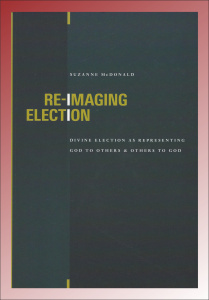 Suzanne McDonald. 2010. Re-Imaging Election: Divine Election as Representing God to Others & Others to God. Grand Rapids: Eerdmans.
Suzanne McDonald. 2010. Re-Imaging Election: Divine Election as Representing God to Others & Others to God. Grand Rapids: Eerdmans.
Review by Stephen W. Hiemstra
Working as a chaplain in an Alzheimer’s unit, I once met an older man, James, who used to wander up and down the halls all day muttering to himself—he spoke nothing but gibberish. When one day I invited James to hear a jazz saxophonist play, he was delighted. While the nurses resisted my taking him, when the music started he stood up, began dancing to the music, and invited several women to join him. More importantly, he began speaking in complete sentences and engaged in real conversation: the music helped him center and he remained cogent for several weeks. For me, the story of James is both a resurrection story and a metaphor for our election—in Christ we are reminded (awakened) of the person who God created us to be.
In her book, Re-Imaging Election, Suzanne McDonald expands on a story similar to James’ story to illustrate how our identity is, in part, relationally held (159). She writes:
“…the parable of dementia has raised three fundamental concepts that pertain to the election to representation: that the reality of our true personhood may be quite radically beyond our knowing; that it may be partially and provisionally held representatively for us by another in ways that have ontological significance; and that this does not compromise our personal particularity, but rather allows another person to become the space in which both who we presently are and the truth about who we are is beyond us may be held.” (164)
McDonald launches into her exploration of election with a question: “Why propose yet another way of thinking about election, and why do so from a Reformed point of view?” The answer follows shortly thereafter: because the “Reformed approach to election [is] fundamentally correct” (xiii). Her exploration builds on the issues and questions posed by John Owen (1616–1683) and Karl Barth (1886–1968) and pays special attention to the role of the Holy Spirit (195).
McDonald views Owen as a “representative of the historic Reformed orthodoxy in the Dordt Tradition” (xviii) and sums up his concept of election in the phrase: “in Christ by the Spirit” (11). She explains:
“The image [divine image or imago dei] having been separated from human nature [in the fall] in all save Christ, it is therefore for the very purpose of revealing and restoring the lost image of God that the eternal Son and essential image of the Father takes our nature as the Mediator of the outworking of the covenant of redemption in the covenant of Grade for those elect in him.” (20)
For Owen, the Holy Spirit plays an instrumental role by renewing in us the divine image (14).
McDonald views Barth likewise holding a high view of the Holy Spirit’s role in election. She writes:
“…in Christ we see the whole predestination of God, such that Jesus Christ alone is the [whole and universal] election of God. Election is ‘in Christ’ because there is for Barth only the one predestining act: God’s self-election to be God-for-us in the person of Jesus Christ.” (60)
Yet…
“As those, ‘without the Spirit,’ the rejected continue to live in futile rebellion against their election.” (61)
At this point, McDonald pivots. A key verse in her doctrine of election is:
“I will bless those who bless you, and him who dishonors you I will curse, and in you all the families of the earth shall be blessed.” (Gen 12:3 ESV)
In other words, we are blessed to be elected to bless others. What is this blessing? The blessing takes the form of the imago dei—the divine image—which the community of faith partakes of and represents to the non-elect (97). Here she offers 3 scriptural principles of election:
“…election entails the setting apart of one clearly delineated community in a unique relationship to God and the world, and it is the Spirit who creates, sets apart, and shapes the new covenantal community in Christ.”
“…the spirit constitutes and shapes the unique perichoretic personhood of the elect that binds together the elect community and the rest of humanity.”
“…election is the expression of—and the chosen means to further—the triune God’s purpose of blessing.” (190-191)
In so many words, the instrumentality of the divine image reflected in the community of faith accordingly allows participation in God’s work without impinging on God’s sovereignty.
Suzanne McDonald is currently a professor of historical and systematic theology at Western Theological Seminary. She is an ordained minister in the Christian Reformed Church. Her doctorate is from University of Saint Andrews in Scotland and she is a native of Australia. Re-Imaging Election summarizes her dissertation and is the first of her two books. Her other book is: John Knox for Armchair Theologians (Westminster John Knox Press, 2013).
McDonald writes Re-Imaging Election in 7 chapters proceeded by an introduction and followed by an epilogue, as follows:
Introduction
Posing a Pneumatological Problem.
Election, the Image, and the Spirit: John Owen.
Election, the Image, and the Spirit: Karl Barth.
Election ‘in Christ’ in Barth: Some Pneumatological Queries.
Re-Presenting the Image; Re-Imaging Election.
Sketching Some Scriptural Contours.
Election, the Spirit, and the Ecclesial Imago Dei.
Election to Representation in Dialogue.
Some Problems, a Parable, and the Parousia.
Owen and Barth: Beyond the Impasse.
Epilogue: Glancing Backward, Looking Forward
Bibliography
Index of Names and Subjects
Suzanne McDonald’s Re-Imaging Election is a captivating read. The doctrine of election is a logical necessity in developing a systematic presentation of the Gospel which makes election interesting to anyone who eschews incoherence. Pastors, seminary students, and armchair theologians in the reformed tradition will accordingly benefit from this book.
Reformed orthodoxy was laid by the Canons of Dordt (1618-19) in five points summarized in the mnemonic “TULIP”: total depravity, unconditional election, limited atonement, irresistible grace, and persistence of the saints. https://en.wikipedia.org/wiki/Calvinism#Five_points_of_Calvinism.
April 3, 2016
22. Prayers of a Life in Tension by Stephen W. Hiemstra
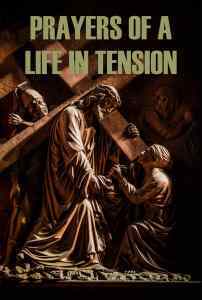 Creator God,
Creator God,
We praise you for creating us in your image, complete in ourselves yet complementary with one another. In you and by your hand, we are never alone. Thank you. Gently remind us of our limitations so as to grow them—remind us when we are tired of the times and the seaons of life; remind us when we are forgetful that we need to keep our promises and realize our potential; remind us when we neglect ourselves, our neighbors, and you that we are not alone and not intended to be alone. Forgive us; restore us; redeem us—teach us to imitate you as you do so that we might grow more and more like you every day. May we ever hunger and thirst for your presence day by day. Through the power of your Holy Spirit and in Jesus’ name, Amen.


April 1, 2016
The Owl
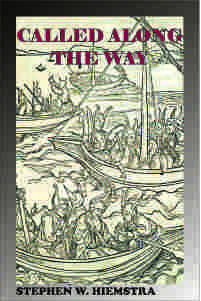 “There is one whose rash words are like sword thrusts,
“There is one whose rash words are like sword thrusts,
but the tongue of the wise brings healing.” (Prov 12:18)
The Owl
By Stephen W. Hiemstra
In eleventh grade I wanted to learn to type. I loved to write letters and often composed my letters with the flourish of a fountain pen, but I was embarrassed that I could only hunt and peck on a typewriter. I envied my Dad who composed his dissertation on an Underwood Manual and now was able to type letters using all the proper keystrokes. For me, typing had caché; typing was professional; I wanted to learn to type.
Parkdale Senior High School [1] offered a typing class for aspiring secretaries, not for students in the college track. When I asked to sign up for the class, my guidance counselor frowned and consented to enroll me only after considerable prodding. Even then, a problem arose because typing was a one-semester course and I needed to choose another one-semester course for the other semester. Reluctantly, I signed up for note-taking. I had no interest or use for note-taking but I rationalized that
at least I was learning to type.
The note-taking class proceeded without a hitch but halfway through the semester my counselor informed me that I had been bumped out of the typing class. In its place, I was enrolled in a psychology class—ugh. What would I ever do with psychology? Psychology?
Psychology started in the new semester with little fanfare. Students enjoyed it because the class had no textbook and no homework. We met for 50 minutes a day sitting in a big circle and just talked. The latest rage in 1971 pop psychology was neither Dale Carnegie nor B.F.Skinner; it was group therapy. In group therapy, everyone got their say, but the price of speaking your mind was that you had to listen to everyone else’s feedback. With more than 20 students in this class, feedback could take a while.
Psychology class was definitely a class off track. I knew almost none of the students from any previous class; the few that I knew were from my gym class. Although at the time I thought of them mostly as strangers, I suspect that these were the students who aspired to the typing and shop classes that my counselor refused to enroll me in. In a graduating class of 750 where half the students did not graduate, a lot of strangers wandered the halls.
One of those strangers—Bill—stood out. Bill was tall and gruff and wore work outfits with plaid shirts. Now, I enjoyed plaid shirts myself and took a ration of grief for wearing blue jeans and boots to school before either were fashionable, but Bill also looked mean—like walk down the other side of the street kind of mean. In fact, on a bad day I might have been afraid of him.
One day in class our assignment was to pick the name of a person out of a hat, compare that person with an animal, and explain why that animal provided a reasonable comparison. I still remember the panic—think of the potential embarrassment—think of the new nickname around school—what was that teacher thinking? As we took our turns, we dreaded the potential for public derision that an animal name might hold for us.[2]
When Bill picked my name, I tensed up. What would he say? How would I respond? But, he quietly said that I was smart like an owl…With those words, my image of him changed—he did not seem so mean after all. I wondered: who is this guy? Over the next few weeks, the stranger that I had observed became a friend that I knew. Later, when I class ended, I missed seeing and talking with him.
Funny, I cannot remember whose name I picked that day.
REFERENCES
Carnegie, Dale. 1981. How to Win Friends and Influence People (Orig pub 1936). New York: Simon and Schuster.
Skinner, B.F. 1971. Beyond Freedom and Dignity. New York: Bantam Books/Vintage Books.
[1] http://www1.pgcps.org/Parkdale.
[2] Public derision was a real possibility. The “flying finkle finger of fate award” was an example made famous by a television show (1968) called Rowan and Martin’s Laugh-In (https://www.youtube.com/watch?v=aYG6L9jcFOE).


March 29, 2016
Sedler: Wisdom With or Without Words
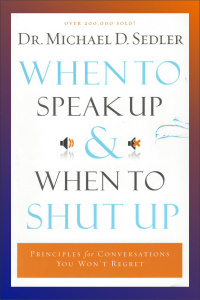 Michael D. Sedler. 2003. When to Speak Up & When to Shut Up: Principles for Conversations You Won’t Regret. Minneapolis: Baker Publishing Company (Chosen).
Michael D. Sedler. 2003. When to Speak Up & When to Shut Up: Principles for Conversations You Won’t Regret. Minneapolis: Baker Publishing Company (Chosen).
Review by Stephen W. Hiemstra
Years ago I made a promise to myself not to give up on life for lack of courage. Courage involves things like trying something different to keep growing; being available to my family (and to others) even when it hurt; finishing the race one step at a time—even if the race is a marathon. Courage—often it has meant being fully present in my own life when important words are spoken. So when I ran across Michael D. Sedler’s book, When to Speak Up & When to Shut Up, I knew that I needed to order a copy.
What does it mean to be fully present in our own lives?
After recounting a marriage counseling session where he [as the counselor] let himself down for not speaking up and defending his own values, Sedler writes:
“This truly is a book about love . . . loving one another enough to understand when we should remain silent and when we should speak…” (16)
He further observes that:
“Our very lives, both physical and spiritual, depend upon our ability and willingness to speak out at the proper moment. And by the same token, silence can bring pain, destruction, and the inevitable onslaught of sin.” (16)
This onslaught of sin is not a throwaway comment; Sedler asks: “Was the ‘original sin’ Eve’s eating the forbidden fruit or was it Adam’s silence while his wife was deceived?” (21) Phrased in this way, Eve can be seen transgressing (doing bad) the law of God while Adam committed iniquity (failure to do good)—technically, both are sins.
An important lesson that Sedler offers comes from the story of David and Goliath found in the first book of Samuel, chapter 17. In the ancient world where battles were crudely fought and carried a horrible penalty for all involved, it was common to delegate the battle to a champion who fought on behalf of the entire nation. The Philistine champion was a giant named Goliath and he made this proposal:
“He stood and shouted to the ranks of Israel, Why have you come out to draw up for battle? Am I not a Philistine, and are you not servants of Saul? Choose a man for yourselves, and let him come down to me. If he is able to fight with me and kill me, then we will be your servants. But if I prevail against him and kill him, then you shall be our servants and serve us.” (1 Sam 17:8-9 ESV)
No one in the army of Israel dared to fight him, except for a young shepherd boy named David (1 Sam 17:32).
Sedler sees 4 principles for speaking up or remaining silent in David’s response to Goliath that enabled him to gain the confidence of King Saul who allowed him to become Israel’s champion. These principles are:
David was prepared (30). As a shepherd, David had battled with bears and lions in protecting his father’s sheep (1 San 17:34-36)
David had a servant heart (33). Today we would say that he had a great attitude—he wanted to encourage his brothers, serve King Saul, and honor God.
David asked questions (34). In preparing to battle Goliath, he asked others about the situation and checked out the reason for their fears.
David concentrated on the problem (Goliath’s challenge), not on criticizing his brothers who appeared to lack courage (37). David was not trying to show off and worked to encourage his brothers (1 Sam 17:45, 47).
What Sedler sees in this account of David and Goliath is that David was a problem-solver and a team player. He was also courageous—he spoke up and stood his ground.
Standing up to giants is one thing, but silence can also be golden. Sedler suggests asking a few questions in contemplating silence:
Why am I silent?
What is my motivation—is it of God?
Will silence further God’s kingdom, clarify the issue, or allow me or others to grow?
Am I second-guessing myself?
Did I suppress the urge to speak? If so, why? (92)
Here again we see Sedler engaging in problem solving and reflection in his decision process rather than reacting hastily.
Sedler describes himself as an ordained pastor, consultant, and adjunct professor at several universities. His degrees are in political science (BA), social work (MS), and ministry (DMin). He has also taught public school and has a Jewish background. He lives and works in Spokane, Washington. Sedler writes in 10 chapters:
Never Again,
When Silence Isn’t Golden,
A Kingly Voice,
Communication Breakdown,
A Question of Authority,
The Code of Silence,
The Purpose of Silence,
Walking in Peace,
Taking a Stand,
Winning the Race (7).
The appendix recounts the story of Sedler’s conversion to Christianity at age 22.
Michael D. Sedler’s When to Speak Up & When to Shut Up is a short (156 pages with appendix), accessible, and an interesting read. He targets a Christian audience. Small groups might find this book a helpful resource in discussion.
Later, he cites the wisdom of Solomon: [there is] “a time to keep silence, and a time to speak” (Eccl 3:7; 17)
March 27, 2016
21. Prayers of a Life in Tension by Stephen W. Hiemstra
You are the alpha and the omega, the beginning and end, the one outside of time that created all things. We praise you for providing the bread of life and well-spring of everlasting life which is your son, Jesus Christ—our redeemer, the author of our faith, and our only true friend. We thank you for simple things, like family, bread to eat, clean water to drink, work to do, and friends in Christ. Through the power of your Holy Spirit who makes all things clear, help us to share our physical and spiritual gifts with those around us—first our family, then our friends, and even those we do not know well so that your name would be praised among the nations. Forgive us when we play the fool out of pride, not for you, but out of our own ignorance. Humble us that we might become worthy servants of your church and not ourselves. Help us to find our identity in you—not in our accomplishments, nor our friends, nor our wealth, but in you—
so that if we play the fool, it is for you and you alone. In Jesus’ precious name, Amen.


Mark 16: Easter

New Life
“And he said to them, Do not be alarmed. You seek Jesus of Nazareth, who was crucified. He has risen; he is not here. See the place where they laid him” (Mark 16:6 ESV).
By Stephen W. Hiemstra
One of the most vivid memories I have as a young person was the experience of an Easter sunrise. Easter is mysterious, earth-shattering news. How could I sleep through it?
At my grandfather’s funeral, I was given a head of wheat which hangs now in my kitchen. The wheat reminds me of Jesus’ saying: “Truly, truly, I say to you, unless a grain of wheat falls into the earth and dies, it remains alone; but if it dies, it bears much fruit” (John 12:24 ESV).
The mystery of resurrection is everywhere in nature. Sunrise is the resurrection of the day. Springtime is the resurrection of the seasons. The metamorphosis from caterpillar to cocoon to adult butterfly is a beautiful, dramatic resurrection. The Apostle Paul writes: “all of creation groans in anticipation of our redemption” (Romans 8:19-23).
Prophesies of Jesus’ resurrection start early in scripture. Systematic theologians see salvation history as creation, fall, and redemption. Because sin is the cause of death, eternal life requires forgiveness of sin which is brought about in Christ’s resurrection. This transition is prophesied in Genesis: “I will put enmity between you and the woman, and between your offspring and her offspring; he shall bruise your head, and you shall bruise his heel” (Gen 3:15 ESV).
Other theologians see resurrection arising out of righteous suffering. The prophet Job writes not only of Christ, but his own resurrection: “For I know that my Redeemer lives, and at the last he will stand upon the earth. And after my skin has been thus destroyed, yet in my flesh I shall see God, whom I shall see for myself, and my eyes shall behold, and not another” (Job 19:25-27 ESV). At the birth of the church on Pentecost (Acts 2:27), the Apostle Peter sees resurrection prophesied by King David: “For you will not abandon my soul to Sheol, or let your holy one see corruption” (Psalm 16:10).
When asked to produce a sign Jesus himself spoke of the sign of Jonah (Luke 11:29-32). In the belly of the whale Jonah prayed: “I called out to the LORD, out of my distress, and he answered me; out of the belly of Sheol I cried, and you heard my voice” (Jonah 2:2 ESV). And the whale spit him out on dry land.
Resurrection did not start with Jesus. Some see the story of the binding of Isaac as a resurrection account and a prophecy of the cross (Genesis 22:1-18). The prophet Elisha raises the Shunammite’s son from the dead (2 Kings 4:32-37). In the valley of bones, Ezekiel prophesied about resurrection (Ezekiel 37:3-6). The exodus of the nation of Israel from Egypt and the return of the exiles from Babylon are both resurrection accounts where a dead nation rises to new life.
In the gospels, Jesus himself performed several resurrections. He raised Jairus’s daughter from the dead (Mark 5:22-43). He raised the widow’s son (Luke 7:12-17). Most remarkably, after lying four days in the tomb he raised Lazarus from death (John 11:1-45). Like other resurrections, Jesus’ healings and exorcisms brought hope where there was none.
Some scholars believe that John Mark’s gospel recorded Apostle Peter’s testimony while he was in Rome during AD 41-54. Mark later traveled with Paul. Mark’s role was to teach about the life of Jesus. Later, Luke may have assumed this role in Paul’s missionary team.
Interestingly, Mark did no see the gospel ending with Jesus. Neither did Luke whose gospel was followed by the Book of Acts. Mark’s gospel starts with: “The beginning of the gospel of Jesus Christ, the Son of God” (Mark 1:1 ESV). Scholars believe that Mark’s gospel ends with the woman going out from the tomb to relay the angel’s message: “But go, tell his disciples and Peter that he is going before you to Galilee” (Mark 16:7 ESV). Likewise, our part in salvation history is to pass on the story. As the hymnist Katherine Hankey (1834-1911) writes: “I love to tell the story, of unseen things above, of Jesus and his glory, of Jesus and his love…” [2]
Christian hope starts with the resurrection: we know that death is not the end of life’s story. And because we know the rest of the story, we can invest in life and live each day with boldness and joy.
Did Abraham believe God would raise Isaac from the dead? Why did the angel have to tell Abraham twice?
[2] www.hymnsite.com/lyrics/umh156.sht

March 26, 2016
Mark 15: Holy Saturday
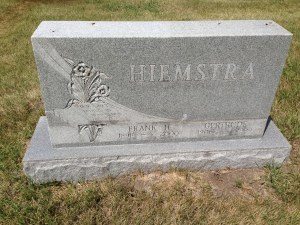 “And Joseph bought a linen shroud, and taking him down, wrapped him in the linen shroud and laid him in a tomb that had been cut out of the rock. And he rolled a stone against the entrance of the tomb.” (Mark 15:46 ESV)
“And Joseph bought a linen shroud, and taking him down, wrapped him in the linen shroud and laid him in a tomb that had been cut out of the rock. And he rolled a stone against the entrance of the tomb.” (Mark 15:46 ESV)
By Stephen W. Hiemstra
Jesus is buried on the Day of Preparation which ends at sundown when the Jewish Sabbath begins. This detail in Mark’s Gospel is important because burial was forbidden on the Sabbath and executed criminals could not hang overnight (Deut 21:23). The Gospels mention nothing taking place on the Sabbath while Jesus lay in the tomb and the narrative resumes on the following day. In other words, Jesus rested in the tomb over the Sabbath. Holy Saturday was a day of mourning and grief.
Grief is more than crying. In Jesus’ Beatitudes, Matthew records: “Honored are those who mourn, for they shall be comforted.” (Matt 5:4) Luke records: “Honored are you who weep now, for you shall laugh.” (Luke 6:21) Both accounts of this Beatitude are written in the form of a lament which has two parts. In the first part, one empties the heart of all grief and pain and anxiety in prayer to God; in the second part, having been emptied the heart turns to God in praise. In the lament, when we grieve, we make room in our hearts for God.
The most famous lament in the Bible is cited by the Gospel of Mark as Jesus’ last words: “My god, my god, why have you forsaken me?” (Mark 15:34) These words come from Psalm 22 verse one which turns to God in verse 19: “But You, O LORD, be not far off; O You my help, hasten to my assistance.” At a time when much of scripture was memorized, rabbis would cite the first part of a passage knowing that the audience would fill in the missing part. Knowing this tradition, Jesus could cite the first verse in Psalm 22 knowing that people hearing him would know the Psalm and how it ended.
Jesus gave us a template for dealing with grief the night before during his prayer in Gethsemane. Mark records that Jesus’ prayed three times: “Abba! Father! All things are possible for You; remove this cup from Me; yet not what I will, but what You will.” (Mark 14:36). Jesus is aware that he stands before the cross and does not want to die; still, he yields to God’s will. Each time we face pain and grief we are faced with a decision: do we turn to God or do we turn into our grief? Our identity is crafted from a lifetime of such decisions.
The story of Joseph of Arimathea is instructive. Mark records: “Joseph of Arimathea, a respected member of the council, who was also himself looking for the kingdom of God, took courage and went to Pilate and asked for the body of Jesus.” (Mark 15:43) Asking for the body of a man just crucified for sedition took guts. Yet, with no expectation of resurrection, on a day when Jesus’ inner circle was in hiding and in fear, Joseph “took courage” and asked Pilate for the body of Jesus. Then, he buried him in his own grave [4].
Holy Saturday is a time to reflect on Christ’s crucifixion. Are we among those happy to see Jesus in tomb or are we looking forward to the kingdom of God like Joseph of Arimathea?
Burial is work, hence forbidden on the Sabbath (e.g. Deut 5:12-15).
Also: Matthew 27:46. The direct citation of an Aramaic expression—“Eli, eli, lama sabachthani?” in both the Mark and Matthew accounts makes it more likely that these are the actual words of Jesus. This is because the most important expressions in the Bible are cited directly rather than translated or, in this case, the actual words are both cited and translated.
Jesus does exactly that in Matthew 21:16 citing Psalm 8:2.
[4] What a picture of substitutionary atonement—Jesus was buried in my grave so that I do not have to be.


March 25, 2016
The Detour
By Stephen W. Hiemstra
When the pickup slowed and the driver looked over at me, I saw only the gun rack. He pulled over ahead of me, got out, and waved me over. I slowed my bicycle and stopped behind the pickup, leaning on one foot—300 hundred miles from home, off my route, and all alone, I felt vulnerable—scared that I might end up like the two bikers in Easy Rider—shotgunned to death. Only in August 1972, I was not motorcycling drugs from California to Florida; I was cycling from Washington DC to start college in Indiana.
“Why did you leave route 50?” His question stoked my anxiety: this guy had obviously followed me for at least the hour trip down route 19 from Clarksburg.
“Route 50 forbids bicycles west of Bridgeport.” I answered. Actually, where route 50 divided into a four-lane highway, the big, green sign had written in white letters: pedestrians, bicycles, motor-driven cycles—prohibited. Elaborating, I continued: “I was detouring south to route 119 where I could continue west.”
He laughed: “We had 10 bicyclists ride through here last week. Nobody cares about that sign…”
“Really? Thanks for the tip.” I responded as the driver returned to his truck.
This gun-rack angel just saved me from a difficult detour and perhaps an extra day’s travel, I figured as he drove off. Still, I was more than an hour’s ride south of Clarksburg, unfamiliar with the area west of route 19, and without a topographical map in the mountains of West Virginia. Studying the traffic map that I had, I could see that local roads could be used to jog over to route 50 at Salem, about 18 miles off—as the crow flies. Just the sort of challenge that Eagle Scouts enjoy, I thought to myself.
With an official BSA yucca backpack slung over the handlebars, I cycled up route 33 that cuts off route 19, Milfort Street, along Sycamore Creek. As the road ascended uphill into the woods, the grading became progressively rougher. Pavement gave way to gravel, which gave way to dirt which gave way to stones, which gave way to transmission-eating boulders. Walking my bike through shaded, old-growth oaks among the boulders at least gave relief from the morning heat.
As the grading improved and I found myself passing tin-roofed shacks—not abandoned, not maintained, just depressing to look at—I found myself in the Appalachia mentioned on television only during election years and then only in passing. Curious locals asked only—”where y’a headed?” —but must have questioned my sanity as I panted up the hill that morning on a 3-speed bike built mostly for city streets.
My thoughts wandered, focused partly on the war—far off in Southeast Asia, yet ever-present in political rallies, school discussions, and family feuds.
My thoughts wandered, focused partly on the endless hillside that I walked more than peddled. By my fourth day on the road I was used to the sunburn, but relieving my hunger would have to wait until I returned to a more populated area. And I hoped that my canteen water would last until I got there.
My thoughts wandered, focused mainly on a friend I desperately wanted to see and foolishly visited my first night out at a camp west of Winchester, Virginia…Now that my foolishness had legs, the remainder of the trip—like life itself—seemed pointless and cruel. Late in the morning and graciously before I lost my mind, the hillside peaked at the ridge and the grading upgraded to macadam for the first time since leaving route 19.
With the ridge, my thoughts quickened. Gone were the oak trees, the dirt road, and Appalachian poverty—they seemed to melt away like the morning mist in afternoon sun. Present now were bluegrass fields neatly grazed, white boarded fences, and country homes with expansive porches—the only thing missing was an icy cold, root beer. As my bike picked up speed gliding down the hill, a black lab on one porch began to take interest and sounded off as he ran down the yard. I paid little attention, continuing to accelerate. What dog can run 40 miles an hour? I thought, more focused on enjoying the breeze as I picked up speed.
Suddenly, I heard growls as the dog snapped at my left foot—this stupid dog was giving serious chase! Still accelerating, I moved my left foot over to stand with both feet on the right peddle. The dog had seen that trick before and moved to snap at me on the right side. Still accelerating, I moved both feet back over to the left peddle. Before the dog could respond, the road veered sharply to the left. Being on the left peddle, I could not lean into it—I was going too fast, could not break, and ran off the right side of the road into the ditch.
My front wheel slid into a roadside sewer and pitched me over the handlebars. I hit the ground on the other side of the ditch hard—sliding and rolling another 20-30 feet. I came to a stop face down: Stunned…Sweating…Speechless…I did not look up; I did not get up; I just lay there barely conscious. No one came running; no one noticed my accident at all.
Finally, I turned my head to see where I was. The dog stood on the road just looking at me. When he saw me look up, he wagged his tail, and wandered off. At that point, I smelled the sewage and sat up not understanding my situation.
I got up and examined my bike. I was sure that it had been ruined, but the front wheel was hardly bent at all. I pulled up a few weeds to clean off the sewage, but I could do nothing about the smell.
I don’t remember much about the trip down route 31 to route 28 and up to Patterson Fork Road that took me into Salem. I remember the heat, the exhaustion, and the hunger; I also remember the anxious desire to call my parents—my emergency dime was ready for action. As I drew closer to Salem, however, I resolved to find a restaurant, to get cleaned up, and to eat lunch before deciding what to do next.
I was feeling sorry for myself as I washed up and got rid of the smell. But my other senses returned as I enjoyed a home-cooked hamburger with fries and that slice of apple pie a la mode. With every bite, I forgot more—more about the dog, more about the foolishness, and more about that irritating smell. Soon, I reflected on the unlikely intervention of that gun-rack angel and I remembered my mileage goal for the day. After lunch, I reported home on my progress, got back on my bike, and cycled on to Ohio.
https://en.wikipedia.org/wiki/Easy_Rider.
BSA is short for Boy Scouts of America.
Mark 15: Good Friday
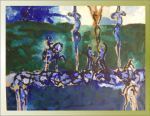
The Crucifixion
“And when the centurion, who stood facing him, saw that in this way he breathed his last, he said, Truly this man was the Son of God!” (Mark 15:39 ESV)
By Stephen W. Hiemstra
Pontius Pilate gets right to the point: “Are you the King of the Jews?” Jesus answers with two words–σὺ λέγεις—which means: you say (Mark 15:2). The chief priests accuse him of many things. Pilate asks Jesus a second question: “Have you no answer to make?” (Mark 15:4) Jesus does not respond (Isaiah 53:7). Pilate is amazed.
The night before, the high priest asked Jesus if he is the Messiah (Christ). Jesus responded using the words God from Exodus 3:14 saying: “I am”. Then, in case anyone misunderstood him, he paraphrased the messianic prophecy in Daniel 7:13: “you will see the Son of Man seated at the right hand of Power, and coming with the clouds of heaven” (Mark 14:62 ESV). The high priest accordingly accused Jesus of blasphemy which is punishable by stoning under Jewish law (Leviticus 24:16). But since Rome reserved the right to decide all cases of capital punishment, the chief priests accused Jesus of the political crime of sedition—treason against Rome. This is why Pilate asked Jesus: “Are you the King of the Jews?” (Mark 15:2)
Realizing that Jesus is innocent of the charge of sedition, like a good politician Pilate begins working the crowd. In offering to release a prisoner named Barabbas, who was guilty of both sedition and murder (Mark 15:7), Pilate is effectively asking the crowd what kind of Messiah they prefer. The crowd asked for Barabbas who was known to be a Jewish nationalist—in other words, the crowd prefers a kingly Messiah.
Messiah means anointed one in Hebrew which translates as Christ in Greek. Three types of roles are anointed: prophets, priests, and kings. In his earthly ministry, Jesus embodied the first two roles (prophet and priest), but the crowd wanted a king—someone to drive the Romans out—as we saw earlier in Mark 11:10.
So Pilate gave them what they wanted (Romans 1:24-25), washed his hands of the decision, and sent Jesus to the cross.


March 22, 2016
Wilbers Outlines the Keys to Great Writing and Then Some
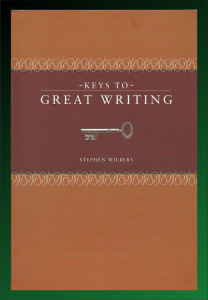 Stephen Wilbers. 2000. Keys To Great Writing. Cincinnati: Writer’s Digest Books.
Stephen Wilbers. 2000. Keys To Great Writing. Cincinnati: Writer’s Digest Books.
Review by Stephen W. Hiemstra
Seminary taught me many lessons, many of which took the form of words. Of course, many words in Greek, Hebrew, and Latin were entirely new to me. But even in English seminary gave me new words to express ideas which were previously unformed and unattended. Writers may find themselves similarly challenged in Stephen Wilbers book: Keys to Great Writing.
What are the keys here? Wilbers lists five keys: economy, precision, action, music, and personality. Let me say a few words about each.
Economy. “Make every word count.” Wilber illustrates his point by chunking up a poem by Langston Hughes, “Harlem”, and asking the reader to edit it by bracketing out unnecessary verbiage. Then, he brackets the verbiage himself. The word count falls from 112 to 54, but the power in the poem rises as the word count falls (11-13). He then moves on to offer fourteen techniques for eliminating wordiness.
My favorite technique was number 5: “Delete ‘hollow’ hedges and meaningless intensifiers” A hollow hedge is an unnecessary qualifier. For example, in the expression, “rather surprised”, the word, surprised, is sufficient which makes the word, rather, a hollow hedge. Likewise, an intensifier normally adds emphasis, but not all emphasis is necessary. For example, the word, very, is everyone’s favorite unnecessary intensifier. Wilber recommends that if the meaning of the expression is unchanged when omitting hedges and intensifiers, then leave them out (21).
Precision. “Use the right word.” Prefer action verbs and concrete nouns; appeal to the five senses; be careful with modifiers; avoid sexist language; speak plainly and directly. (37-47).
Action. “Use action and movement to engage your reader.” Wilbers reinforces his earlier comments here about action verbs and cautions about pompous nouns—nominalizations. What makes this presentation differ from a typical treatment is that Wilber includes punctuation in this discussion and outlines rules for using both nominalizations and the passive voice. For example, he offers five reasons to use passive voice:
To emphasize the receiver of the action.
To de-emphasize the performer of the action.
To avoid responsibility.
To create smooth connections between sentences.
To maintain a consistent point of view or sequence of subjects (56-57).
His treatment here stresses the principle that a skilled writer uses language forms appropriately rather than blindly following rules.
Music. Wilbers advises the reader to “listen to your voice”. Language is simply a representation of the spoken word (67-68).
In representing the spoken word, Wilbers classifies punctuate marks into three categories: marks of clarification (hyphens, quotation marks, and parentheses), marks of inflection (question marks and exclamation marks) and marks of separation (periods, commas, semicolons, and dashes) (72). He then offers a rhythmic interpretation of separation marks. Think of a period as a whole note rest; a colon as a three-quarter note rest; a semicolon as a half-note rest; and a comma as a quarter-note rest (73-75).
Another important way to represent the spoken word is through using different sentence structures. Wilber classifies twelve sentence types in three broad categories: functional (declarative, interrogative, imperative, and exclamatory) sentences, grammatical (simple, compound, complex, and compound complex) sentences, and rhetorical (periodic, loose, balanced, and antithetical) sentences (89). Some of these sentence types are familiar; others require definition. A sentence type new to me, for example, was a periodic sentence which is defined as a compound sentence where the subordinate clauses precede the main clause creating a sense of expectation. A loose sentence does exactly the opposite having the main clause precede the subordinate clauses (89).
Personality. Wilbers advises writers to “be lively, unpredictable, playful, and genuine” (107). For example, Wilbers writes: “A good metaphor has three qualities: aptness, novelty, and simplicity” which might satisfy each of these conditions. (114) More generally, this chapter pulls together elements from the previous chapters and talks about how to use them.
The five keys are discussed in the first five of Wilbers’ eleven chapters. The complete list of chapters are:
Part One: Keys to Great Writing
1. Economy.
2. Precision.
3. Action.
4. Music.
5. Personality.
Part Two: Elements of Composition
6. Purpose.
7. Point of View.
8. Organization.
9. Support.
10. Coherence.
Part Three: Drafting and Revising
11. The Writing Process.
Part one described above accounts for 126 of 262 pages, or about half of the book.
Part two is perhaps of the most interest to experienced writers. For example, Wilbers reviews six purposes for writing:
1. To inform the reader.
2. To entertain the reader.
3. To persuade the reader.
4. To transact business (or accomplish a task).
5. To express oneself.
6. To create a literary work (131).
Note that the first three purposes focus on the reader and the last three focus on the writers—the more that you know about why you write, the more precise the writing will be. Clearly, how you write informs what gets written.
Having offered a flavor of Wilbers’ writing, let me sum up.
Stephen Wilbers book, Keys to Great Writing, outlines the major themes of writing without narrowing the focus to a particular genre. While this makes his book suitable as a composition textbook for college students, it has an engaging style which does not feel like a textbook. Authors serious about moving their writing style to a higher level will want to take notice.











